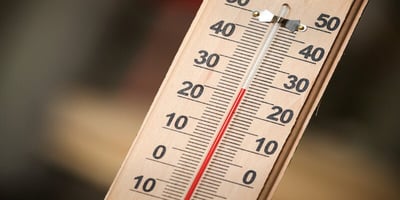Why is Your Room So Hot Compared to the Rest of the House? Common Reasons
At one point in your lifetime, you may have wondered why one room in your home felt unbearably warmer than others. This is quite a common but very irritating and uncomfortable problem, more so in the warm months. Factors that cause room temperatures to be inharmonious range from problems in the insulation to inefficiency in the HVAC system. In this article, we will explore some of the most common reasons for this temperature disparity and provide you with some practical solutions for realizing a more balanced and comfortable environment indoors.
Common Reasons for Inconsistent Room Temperature
Poor insulation
It is one of the key causes of large disparities in temperature from one room to another. If the walls, ceiling, or windows in your room are not well insulated, they will let outdoor temperatures impact the indoor climate much more. For example, there's the fact that, during summer, rooms with bad insulation trap warm air and let cool air escape. The implication is that the room will be hotter than the rest of your house. Add weather-stripping insulation, insulated drapes, or double-pane windows to help avoid extreme temperature imbalances in your home.
Ineffective Ventilation
The poor design and blocked vents surely change the airflow, which causes some rooms to have temperature discrepancies. And when there are items like furniture and drapes that block air vents, the air from it won't circulate properly all around your space. Furthermore, what can also happen is that some vents are delivering too much air compared to others; the result is the cooling or heating of certain rooms inadequately. This makes it very important to ensure that all vents are free and balanced. Regular cleaning and professional check-ups of your ventilation system help work out these issues.
Sun Exposure
Direct sunlight is a strong driver when it comes to increasing the temperature of a room, especially that room with giant windows that are sun-facing during peak times of the day. The room can easily be made a greenhouse by sunlight entering through the windows and bunkers all the heat within the room. The installation of light-colored blinds, reflective window films, or darkening curtains at the windows reduces this effect by blocking or reflecting sun rays. Shade trees or awnings installed on the exterior side of the windows can reduce heat gain brought about by direct sunlight.
HVAC System Issues
Common issues with the HVAC system involve faulty ductwork that is ripped and has holes, malfunctioning air conditioning, or the wrong size of the system, which will lead to uneven cooling. Leaky ducts lose cooled air before they reach certain rooms- a situation similar to when your air conditioner is too small for your home, hence failing to cool the whole house. If your HVAC system is not balanced, you could have some rooms receiving more airflow than others. This will also serve to even the cooling that will be distributed in the house, averting such issues through regular maintenance, such as the making of ducts airtight, servicing the air conditioner, and the right sizing of the system.
Heat-Producing Electronics
Electronic gadgets and appliances may also be additional sources of heat inside the room. Computers, televisions, game stations, and kitchen appliances could all generate heat, especially when running for long periods of time. Placing them in well-ventilated locations and switching them off when they are not being used will reduce their effects on room temperatures. Besides, purchasing energy-saving appliances and having space for airing around the electronic appliances will help reduce the heat.
.png?width=740&height=370&name=image_2024-07-17_19-53-53%20(1).png)
Identify Insulation Problems
Inspection of Wall and Attic Insulation
Inadequate or damaged insulation in the walls and attic of a home can lead to extreme changes in temperature. The following steps will help you inspect and enhance the insulation of your house:
- Visual Check: Look for any evident gaps, cracks, or deteriorated insulation on walls and attics. Using a flashlight, check areas of thin or missing insulation.
- Touch Test: On a hot day, one should just touch the walls and ceiling. If they feel hot, it shows that there is not enough insulation.
- Infrared Thermometer: One may direct an infrared thermometer at the walls and ceilings in search of hot spots, which will indicate insulation failures.
- Blower Door Test: A professional blower door test is recommended to detect air leakages and assess the overall insulation performance.
- Insulate better: Install or upgrade the insulation with materials like fiberglass, cellulose, or spray foam insulation.
Window Insulation Measures
One of the strongest sources of heat gain is through windows. The following are the ways of making window insulation effective:
- Weather Stripping: Seal the gaps located around the window frames to prevent any leakage.
- Caulking: Fill in the cracks and crevices existing around the windows with caulk to seal on drafts.
- Insulated Curtains: Install insulated or thermal curtains to prevent heat from coming through the windows.
- Window Films: Apply reflective or tinted window films to exclude solar heat from entering through your windows.
- Double-Pane Windows: Upgrade to double-pane or energy-efficient windows, as the insulation system is much better than that of a single-pane window.
Increasing the Efficiency of Ventilation
Unblocking and Adjusting Vents
For proper and even distribution of the temperature in your home, there is the need to have a free flow rate of air. Here is how to eliminate and adjust obstructions at the vent:
- Remove Obstructions: Be sure that furniture, drapes, and other items are not blocking the vents. Clean out any blockages or dust accumulation that may be stopping airflow.
- Adjust Vent Louvers: Adjust the louvers inside the vents to direct airflow into the middle of the room, enhancing circulation.
- Clean Vents and Ducts: Clean vent covers and dust ductwork to prevent dust or debris from restricting airflow.
- Balance Airflow: If there are some rooms in your house that seem to get more air than others, you can try to equalize the airflow by adjusting the dampers in your duct system.
Using Fans and Air Circulators
Use fans and air circulators to enhance the air movement and to spread cool air around more evenly. Get to-the-point maintenance tips with the list below:
- Ceiling Fans: Invest in ceiling fans and operate the blades counterclockwise throughout summer to create a cooling breeze.
- Portable Fans: Use portable fans to move cooler air from cooler to warmer rooms.
- Exhaust Fans: Operate exhaust fans in bathrooms and kitchens to draw out hot air and lower humidity.
- Cross-Ventilation: Open up doors and windows on the other side of the room or in other rooms of the house to create cross-ventilation.
- Air Circulators: Place all air circulators strategically to improve air movement and balance a room's temperature.
Amount of Sun
Fixing Blinds and Curtains
The installation of both blinds and curtains will ensure that the rooms receive a minimum amount of direct sunlight. Therefore, the amount of heat that reaches the room will be greatly reduced. The following are the benefits of the installation of both blinds and curtains:
- Reduction of Heat: Heat enters a room much less effectively because blinds and curtains block some sun rays or reflect them away.
- Saving Energy: The installation of these gadgets will reduce the use of air conditioning; thus, the cost of lots of energy will be reduced.
- UV Protection: It protects furniture, flooring, and decor from fading caused by the sun's UV rays.
- Privacy and Light Control: It allows for privacy and control of the amount of sunlight to create a comfortable ambiance within the room.
How to Use Window Films
Window films help cut the heat of the sun. Here is an idea of how it does so:
- Reflective Properties: Window films reflect a significant portion of the sun's rays, thus preventing a significant amount of heat from entering through the windows.
- Energy Savings: When the indoor temperature is well-regulated, the use of window films reduces the load on your cooling system. This has consequential positive effects on energy consumption and savings.
- Reduction of Glare: They greatly reduce glare, hence improving comfort while working on computers or watching your TV.
- Ease of Installation: When compared to other forms of technology, the application of window film is relatively straightforward and can even be a low-cost alternative for homeowners wanting to improve their homes' energy efficiency.
.png?width=740&height=370&name=image_2024-07-17_19-53-19%20(1).png)
Addressing HVAC System Issues
Role of Regular Maintenance and Cleaning
- System Efficiency: Routine maintenance, including cleaning and replacing filters, keeps the HVAC system running efficiently, preventing overheating and overworking.
- Longevity: Regular maintenance guarantees that your HVAC system will serve you for longer, eliminating costly repairs and replacements.
- Air Quality: Air quality improves because clean filters trap dust, pollen, and other airborne particles.
- Consistent Cooling: A regular checkup would allow easy identification of issues and their repair, which may cause an imbalance in cooling; therefore, all space could be maintained at the desired temperature.
Air Ducts Balancing
Properly balanced air ducts are the key to evenly distributing temperature throughout your home. Here's how:
- Inspect Ductwork: Check for visible leaks or blockages that can be affecting airflow.
- Adjust Dampers: Dampers on your duct system may allow varying your home for airflow to different parts of your house, balancing the temperatures within different parts of your house.
- Professional Inspection: You may require hiring an experienced professional who will inspect and rebalance your HVAC system so that it works as efficiently as possible for top performance.
- Duct Sealing: All the ducts should be sealed properly to prevent air leakage and temperature differences.
Reducing Electronics Heat Gain
Reducing the Usage of Heat Producing Appliances
Reduce the use of heat-producing devices or equipment in your home, creating a cool environment. Here's what you can do:
- Turn Off When Idle: All equipment, including computers, televisions, and game consoles, should be powered down when not in use to prevent the generation of heat.
- Energy-Efficient Gadgets: Utilize energy-efficient gadgets and electronics that will produce less heat with less power consumption.
- Power-Saving Mode: Run your devices' power-saving modes to reduce energy consumption and minimize heat production.
- Unplug Chargers: Take unplugged chargers and other connecting devices out while not in use, as most often, they continue to generate some amount of heat even when they are not actually recharging any device.
.png?width=740&height=370&name=image_2024-07-17_19-54-38%20(1).png)
How to Place Electronics
Proper placing of your electronics would help keep the least vulnerable to heat buildup within your premises. The following suggestions explain ways for ideal placement:
- Ventilated Areas: Keep the electronics in well-ventilated spots where they will have ample air to facilitate the cooling effect by dissipating the produced heat.
- Away from the Heat Source: Keep all devices away from direct sunlight and heat sources, such as ovens or heaters.
- Elevated Placement: Keep devices off the floor to allow for a good amount of space so air can flow through easily.
- Cooling Accessories: Use cooling pads or fans to keep devices like laptops cool at a lower temperature rating because they tend to rise in temperature.
These temperature gaps in your room can be quite distressing, but knowing exactly what is wrong can half-solve the problem. You can do this by looking after your insulation, ventilation, sun exposure, and the performance of the HVAC system. Doing this will give you an experience of a much more even and comfortable climate in your whole house. This will secure increased comfort for you but also enhance your energy efficiency and lower overall cooling costs.


































-1.png)
.jpg?height=200&name=photo_2024-10-03_18-57-40%20(1).jpg)


.jpg?height=200&name=beautiful-shot-fabulous-autumn-scene%20(1).jpg)